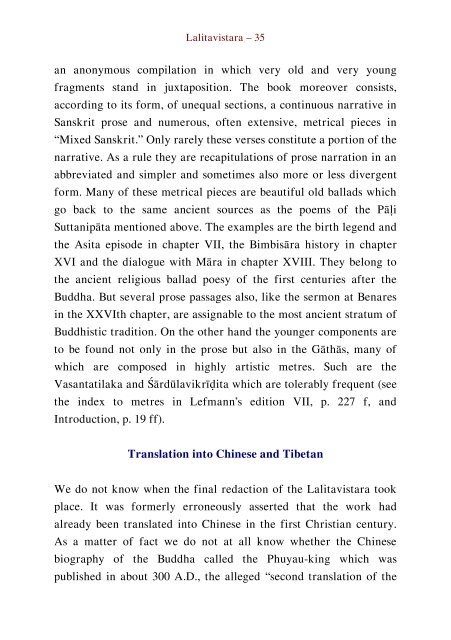Literary History of Sanskrit Buddhism
A study by J. K. Nariman of Sanskrit Buddhism from the Early Buddhist Tradition up to the Mahayana texts proper.
A study by J. K. Nariman of Sanskrit Buddhism from the Early Buddhist Tradition up to the Mahayana texts proper.
You also want an ePaper? Increase the reach of your titles
YUMPU automatically turns print PDFs into web optimized ePapers that Google loves.
Lalitavistara – 35<br />
an anonymous compilation in which very old and very young<br />
fragments stand in juxtaposition. The book moreover consists,<br />
according to its form, <strong>of</strong> unequal sections, a continuous narrative in<br />
<strong>Sanskrit</strong> prose and numerous, <strong>of</strong>ten extensive, metrical pieces in<br />
“Mixed <strong>Sanskrit</strong>.” Only rarely these verses constitute a portion <strong>of</strong> the<br />
narrative. As a rule they are recapitulations <strong>of</strong> prose narration in an<br />
abbreviated and simpler and sometimes also more or less divergent<br />
form. Many <strong>of</strong> these metrical pieces are beautiful old ballads which<br />
go back to the same ancient sources as the poems <strong>of</strong> the Pāḷi<br />
Suttanipāta mentioned above. The examples are the birth legend and<br />
the Asita episode in chapter VII, the Bimbisāra history in chapter<br />
XVI and the dialogue with Māra in chapter XVIII. They belong to<br />
the ancient religious ballad poesy <strong>of</strong> the first centuries after the<br />
Buddha. But several prose passages also, like the sermon at Benares<br />
in the XXVIth chapter, are assignable to the most ancient stratum <strong>of</strong><br />
Buddhistic tradition. On the other hand the younger components are<br />
to be found not only in the prose but also in the Gāthās, many <strong>of</strong><br />
which are composed in highly artistic metres. Such are the<br />
Vasantatilaka and Śārdūlavikrīḍita which are tolerably frequent (see<br />
the index to metres in Lefmann’s edition VII, p. 227 f, and<br />
Introduction, p. 19 ff).<br />
Translation into Chinese and Tibetan<br />
We do not know when the final redaction <strong>of</strong> the Lalitavistara took<br />
place. It was formerly erroneously asserted that the work had<br />
already been translated into Chinese in the first Christian century.<br />
As a matter <strong>of</strong> fact we do not at all know whether the Chinese<br />
biography <strong>of</strong> the Buddha called the Phuyau-king which was<br />
published in about 300 A.D., the alleged “second translation <strong>of</strong> the


















